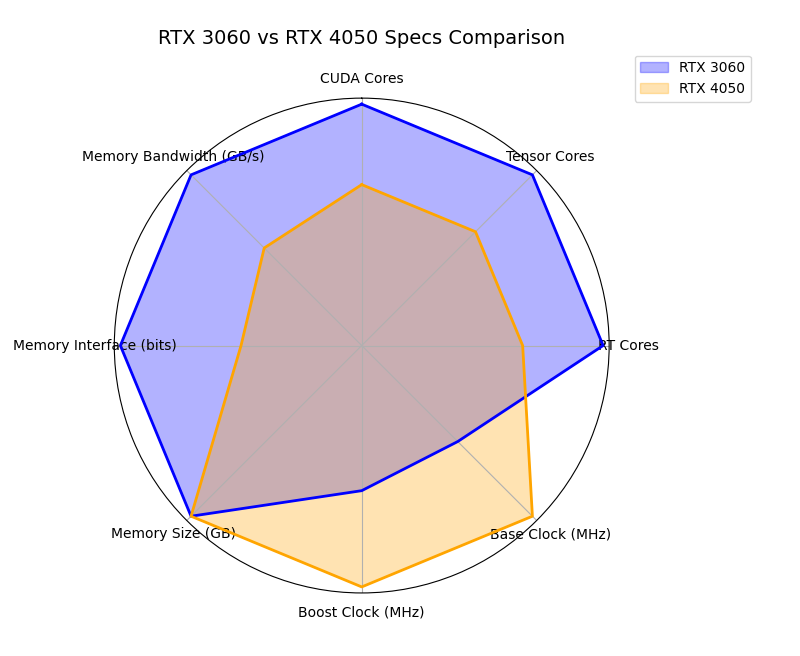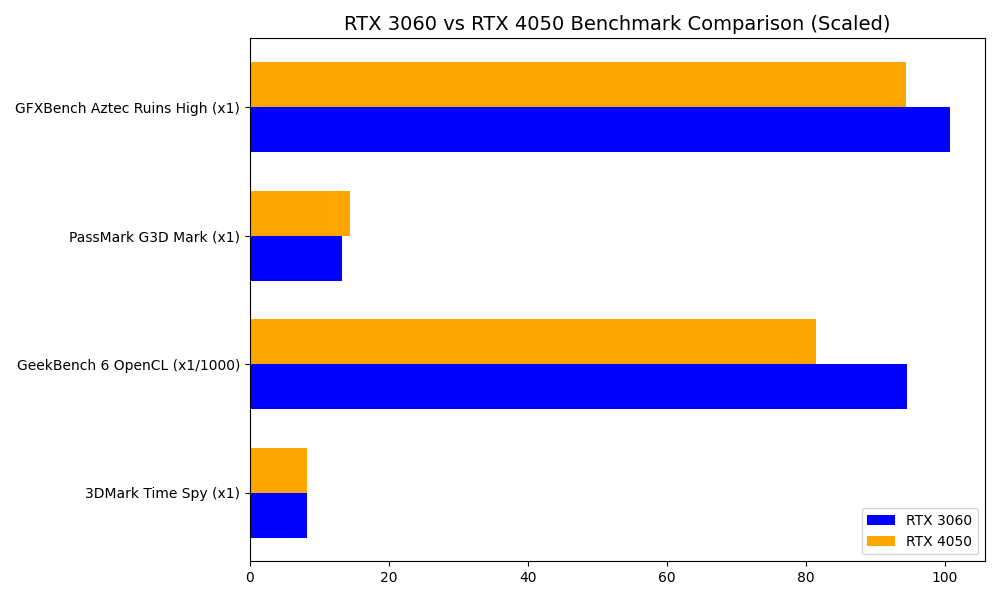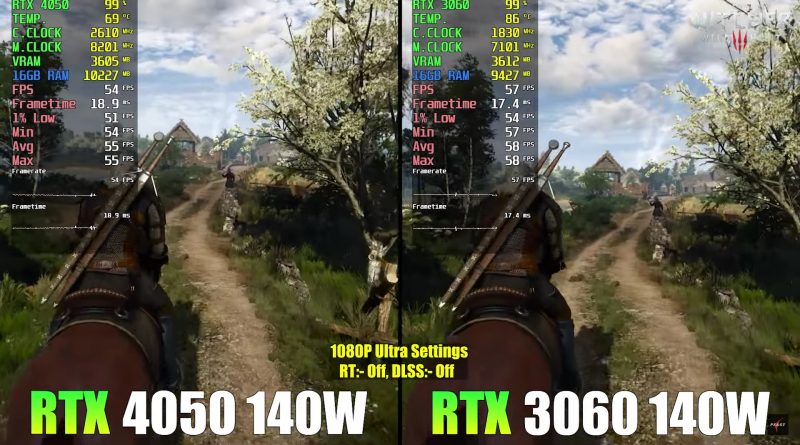3060RTX (Laptop) vs 4050RTX (Laptop)
1. Specifications : 4050RTX vs 3060RTX

| Specification | RTX 3060 Laptop GPU | RTX 4050 Laptop GPU |
|---|---|---|
| Architecture | Ampere | Ada Lovelace |
| CUDA Cores | 3,840 | 2,560 |
| Tensor Cores | 120 | 80 |
| RT Cores | 30 | 20 |
| Base Clock | 900 MHz | 1,600 MHz |
| Boost Clock | 1,425 MHz | 2,370 MHz |
| Memory Size | 6 GB GDDR6 | 6 GB GDDR6 |
| Memory Interface | 192-bit | 96-bit |
| Memory Bandwidth | 336 GB/s | 192 GB/s |
| TGP Range | 60W – 115W | 35W – 115W |
| Dynamic Boost (Additional) | +15W to +25W | +15W to +25W |
| Max TGP (With Dynamic Boost) | Up to 140W | Up to 140W |
| TDP (at Max TGP) | ~115W | ~115W |
| Manufacturing Process | 8nm | 5nm |
Note: Specifications may vary based on laptop manufacturer configurations.
The following conclusions assume, both 3060RTX and 4050RTX run at the highest wattages.
1. Architecture: Ampere vs. Ada Lovelace
- RTX 3060 uses the Ampere architecture (8nm), while the RTX 4050 leverages the newer Ada Lovelace architecture (5nm).
- Impact: The Ada Lovelace architecture is significantly more power-efficient, enabling the RTX 4050 to achieve comparable or better performance than the RTX 3060 at lower TGPs. This is especially beneficial for thinner, lighter laptops with limited cooling systems.
- Example: An RTX 4050 at 80W may deliver performance close to an RTX 3060 at 115W in some scenarios.
2. CUDA, Tensor, and RT Cores
- The RTX 3060 has more CUDA cores (3,840), Tensor cores (120), and RT cores (30) compared to the RTX 4050, which has 2,560 CUDA cores, 80 Tensor cores, and 20 RT cores.
- Impact: In tasks that scale directly with core counts, such as parallel computing and rendering, the RTX 3060 will have an edge.
- However, the RTX 4050’s architectural improvements and higher clock speeds often compensate, making it competitive despite fewer cores.
- Example: In Blender Cycles rendering, the RTX 3060 may slightly outperform the RTX 4050.
3. Clock Speeds: Base and Boost
- The RTX 4050 has significantly higher base and boost clock speeds (1,600 MHz base, 2,370 MHz boost) compared to the RTX 3060 (900 MHz base, 1,425 MHz boost).
- Impact: The RTX 4050’s higher clock speeds translate to better single-threaded and less-parallelized performance, especially in gaming and lighter workloads.
- Example: In gaming at medium settings, the RTX 4050 may achieve higher frame rates in certain titles, even at a lower TGP. This is because medium settings require much less “CUDA cores”.
For example, it may require 500 CUDA cores to run at low settings since both the 3060RTX and 4050RTX have more than 500 CUDA cores, the performance difference is down to how fast each CUDA core can run. Thus the 4050RTX outperforming the 3060RTX.
4. Memory Configuration
- The RTX 3060 features a 192-bit memory interface with 336 GB/s bandwidth, while the RTX 4050 has a narrower 96-bit interface with 192 GB/s bandwidth.
- Impact: The RTX 3060 is better suited for tasks that require higher memory throughput, such as:
- 4K gaming with high-resolution textures.
- Data-intensive rendering workloads.
- Example: In games or applications requiring large texture loads, the RTX 3060 may show an advantage over the RTX 4050.
- Impact: The RTX 3060 is better suited for tasks that require higher memory throughput, such as:
5. TGP and Dynamic Boost
- Both GPUs support TGP configurations up to 115W with Dynamic Boost allowing up to 140W, but the RTX 4050 can achieve better performance at lower TGP levels thanks to Ada Lovelace’s efficiency.
- Impact: The RTX 4050 provides similar or better performance than the RTX 3060 in laptops with lower TGP configurations (e.g., 80W or less).
- Example: In a thin-and-light laptop with an 80W TGP configuration, the RTX 4050 will outperform the RTX 3060 due to its power efficiency.
6. Power Efficiency
- The 5nm Ada Lovelace process of the RTX 4050 is far more power-efficient than the 8nm Ampere process of the RTX 3060.
- Impact: Laptops with the RTX 4050 will run cooler, quieter, and offer longer battery life compared to those with the RTX 3060 at similar performance levels.
2. Benchmarks: 4050RTX vs 3060RTX
Note that benchmarks for the 4050RTX are limited due to its relatively early release compared to the 3060RTX.
Also note that these benchmarks are not really conclusive to say if a laptop with either of these GPUs is faster for a given application since performance realies heavily on wattage and cooling system as well CPU-pairing.

| Benchmark | RTX 3060 Laptop GPU | RTX 4050 Laptop GPU |
|---|---|---|
| 3DMark Time Spy | 8,324 points | 8,208 points |
| PassMark G3D Mark | 13,353 points | 14,442 points |
| GeekBench 6 OpenCL | 94,459 points | 81,436 points |
| GFXBench Aztec Ruins High | 100.7 FPS | 94.4 FPS |
Note: These scores are sourced from NanoReview and PassMark.
Important Nuances to Consider
- TGP Variations: Performance varies significantly depending on the GPU’s TGP (e.g., 60W, 80W, 115W, or 140W with Dynamic Boost). Higher TGP configurations will outperform lower TGP versions, regardless of the GPU model.
- Cooling System: Laptops with robust cooling systems allow GPUs to maintain higher sustained clock speeds, directly impacting performance.
- CPU Pairing: A powerful CPU reduces bottlenecks and enhances GPU performance, especially in compute-heavy workloads like rendering or gaming.
3DMark Time Spy
-
- The RTX 3060 scores 8,324 points, slightly outperforming the RTX 4050’s 8,208 points (~1.4% difference).
- Interpretation:
- The RTX 3060 may provide slightly better performance in DirectX 12 gaming scenarios, especially at higher resolutions or ultra settings.
- However, the RTX 4050’s support for DLSS 3 (exclusive to Ada Lovelace) makes it highly competitive in modern, optimized games.
- Nuances:
- At lower TGPs (e.g., 80W), the RTX 4050 may match or outperform a lower-TGP RTX 3060 due to Ada Lovelace’s efficiency.
- In laptops with limited cooling, both GPUs might throttle, skewing real-world results.
GeekBench 6 OpenCL
-
- RTX 3060: 94,459 points
- RTX 4050: 81,436 points
- Interpretation:
- The RTX 3060 leads by ~16%, showcasing better performance in parallel workloads like image processing, simulations, or machine learning.
- This advantage is primarily due to its higher CUDA core count and wider memory interface.
- Nuances:
- Lower TGP configurations or weaker CPU pairings can bottleneck the RTX 3060, narrowing the gap.
- Compute-heavy applications may not fully utilize the RTX 4050’s newer architecture.
PassMark G3D Mark
-
- RTX 3060: 13,353 points
- RTX 4050: 14,442 points
- Interpretation:
- The RTX 4050 scores ~8% higher overall, indicating better general-purpose GPU performance in a balanced TGP configuration.
- Efficiency gains from the Ada Lovelace architecture help the RTX 4050 excel in everyday tasks and lighter gaming workloads.
- Nuances:
- Higher TGP configurations of the RTX 3060 may outperform lower-TGP RTX 4050 laptops in sustained workloads.
Author Profile
- I am physicist and electrical engineer. My knowledge in computer software and hardware stems for my years spent doing research in optics and photonics devices and running simulations through various programming languages. My goal was to work for the quantum computing research team at IBM but Im now working with Astrophysical Simulations through Python. Most of the science related posts are written by me, the rest have different authors but I edited the final versions to fit the site's format.
Latest entries
 wowDecember 18, 20255 Best Laptops For World of Warcraft – Midnight & Classic (2026)
wowDecember 18, 20255 Best Laptops For World of Warcraft – Midnight & Classic (2026) LaptopsDecember 17, 2025The 4 Best Laptops For Virtualization of 2026 (10-50 VMs ATSM)
LaptopsDecember 17, 2025The 4 Best Laptops For Virtualization of 2026 (10-50 VMs ATSM) Hardware GuideDecember 17, 20252026 Beginner Guide to Reading Computer (Laptop) Specifications
Hardware GuideDecember 17, 20252026 Beginner Guide to Reading Computer (Laptop) Specifications LaptopsJune 30, 2025Best Laptops for Computer Science (July 2025 )
LaptopsJune 30, 2025Best Laptops for Computer Science (July 2025 )

